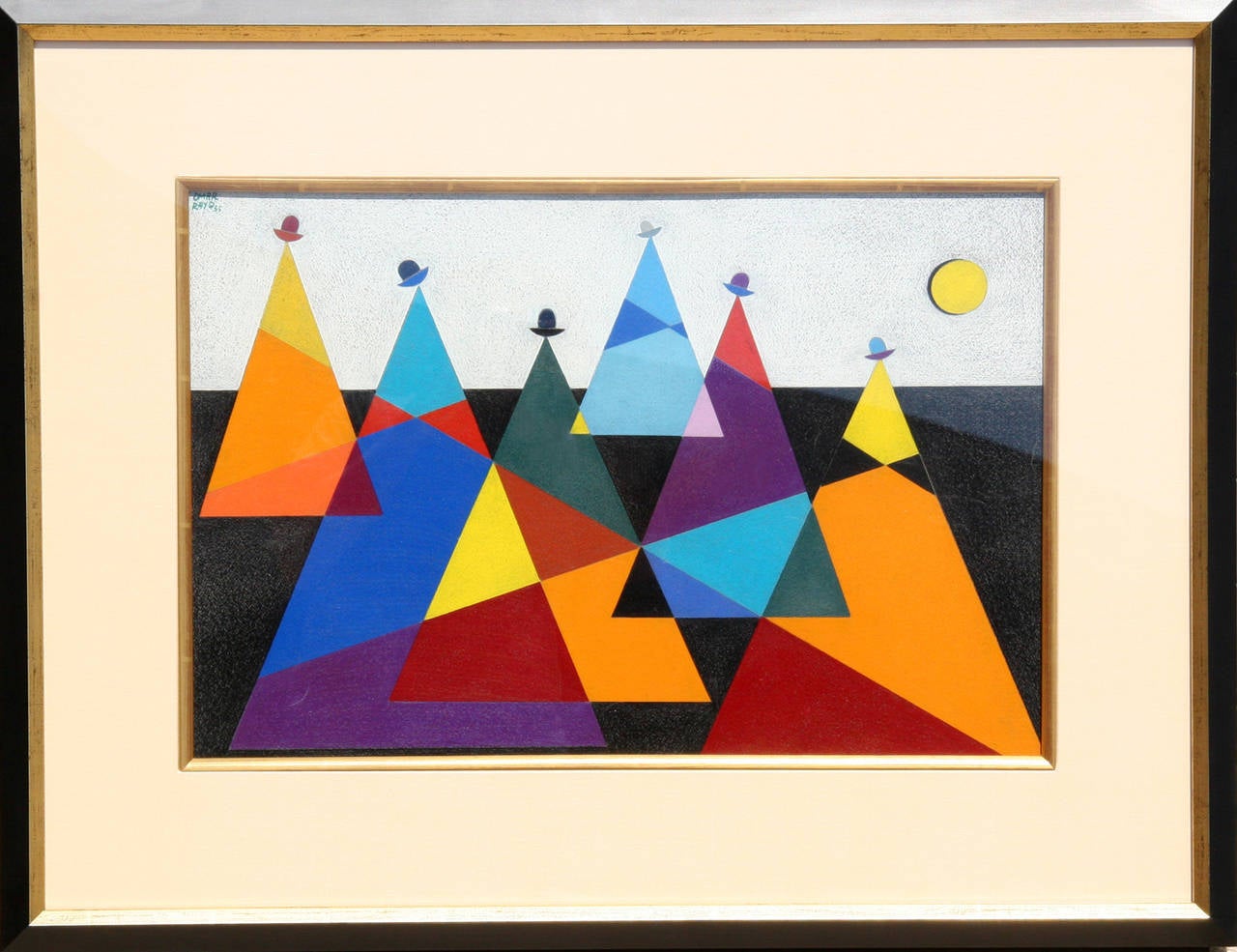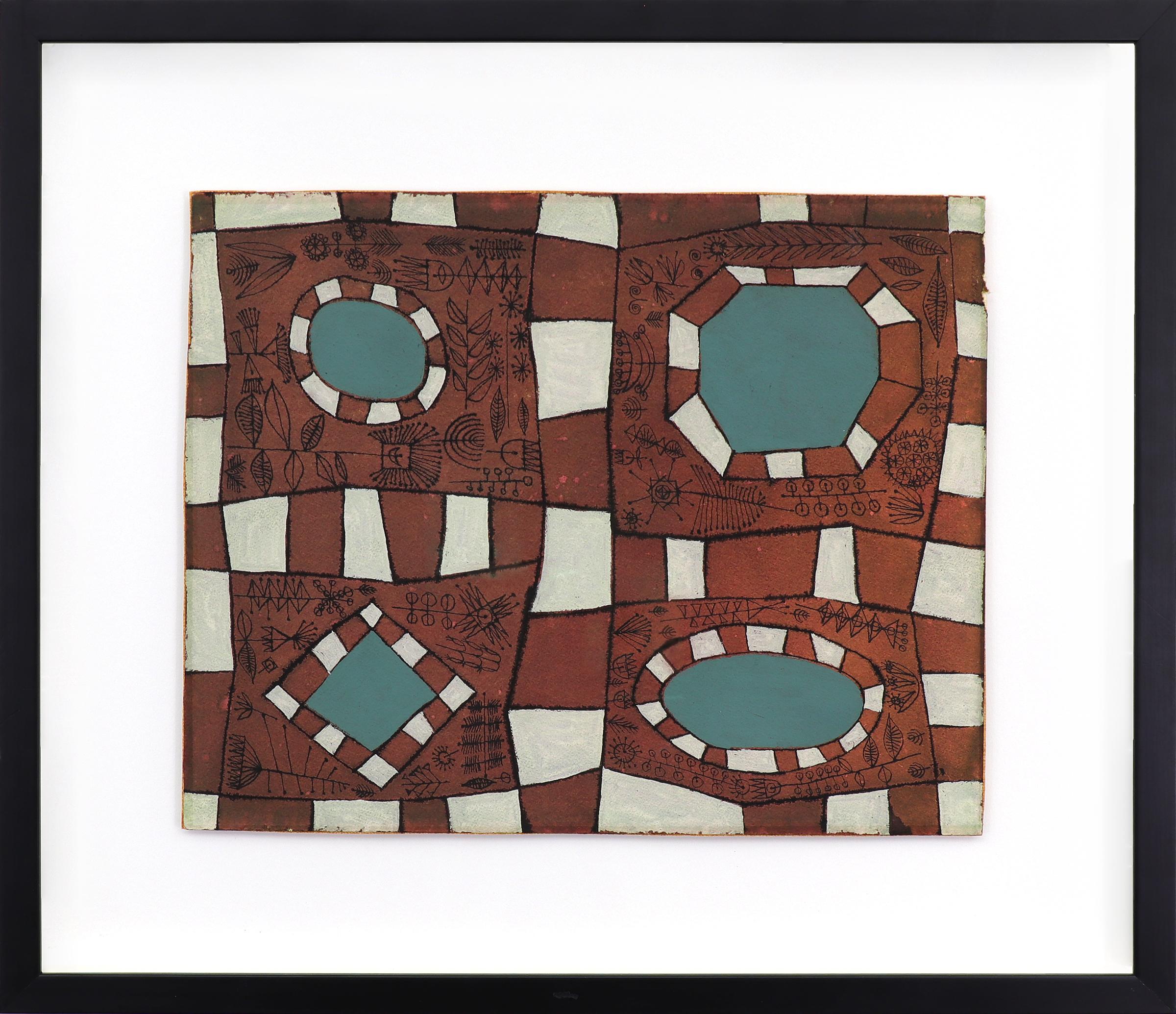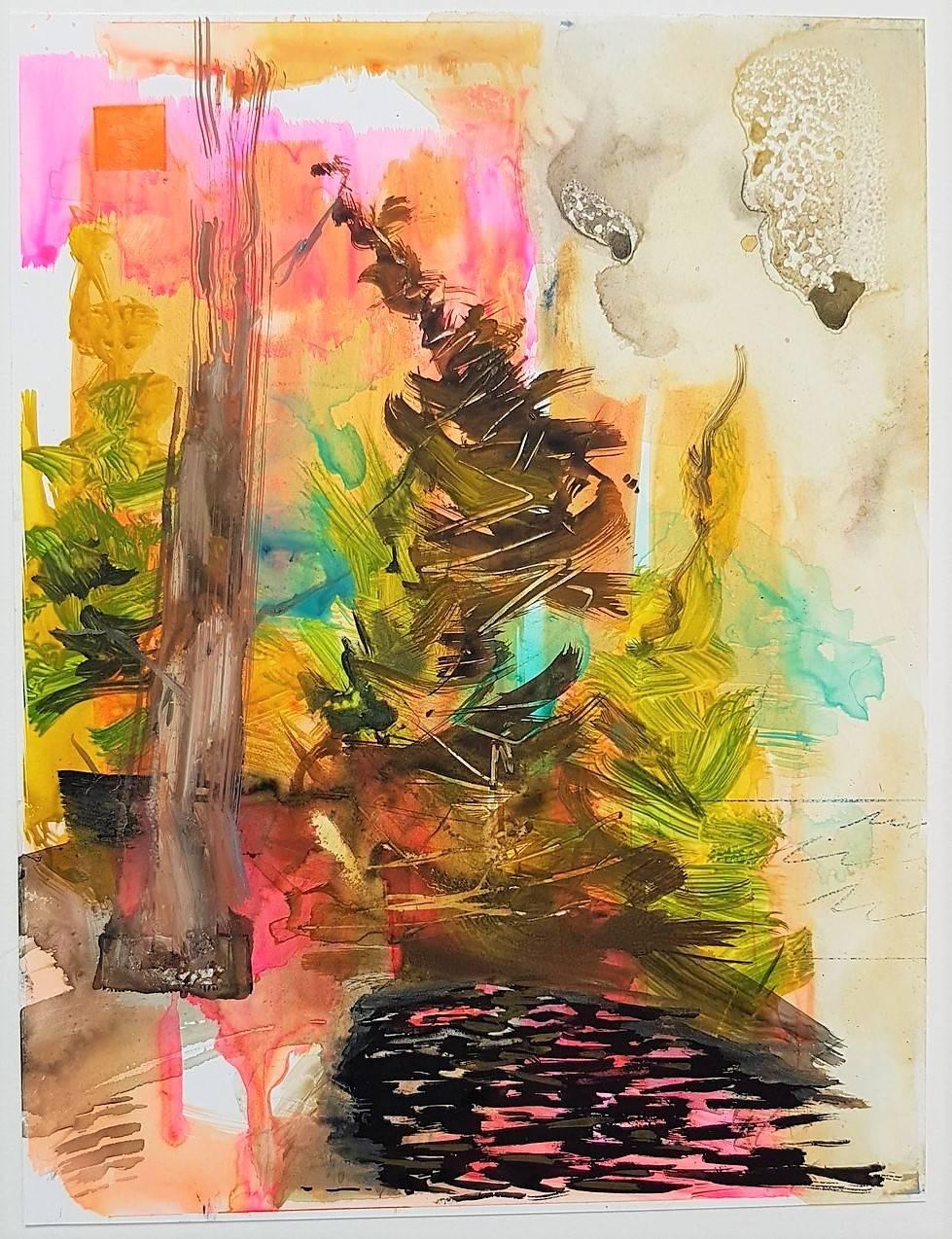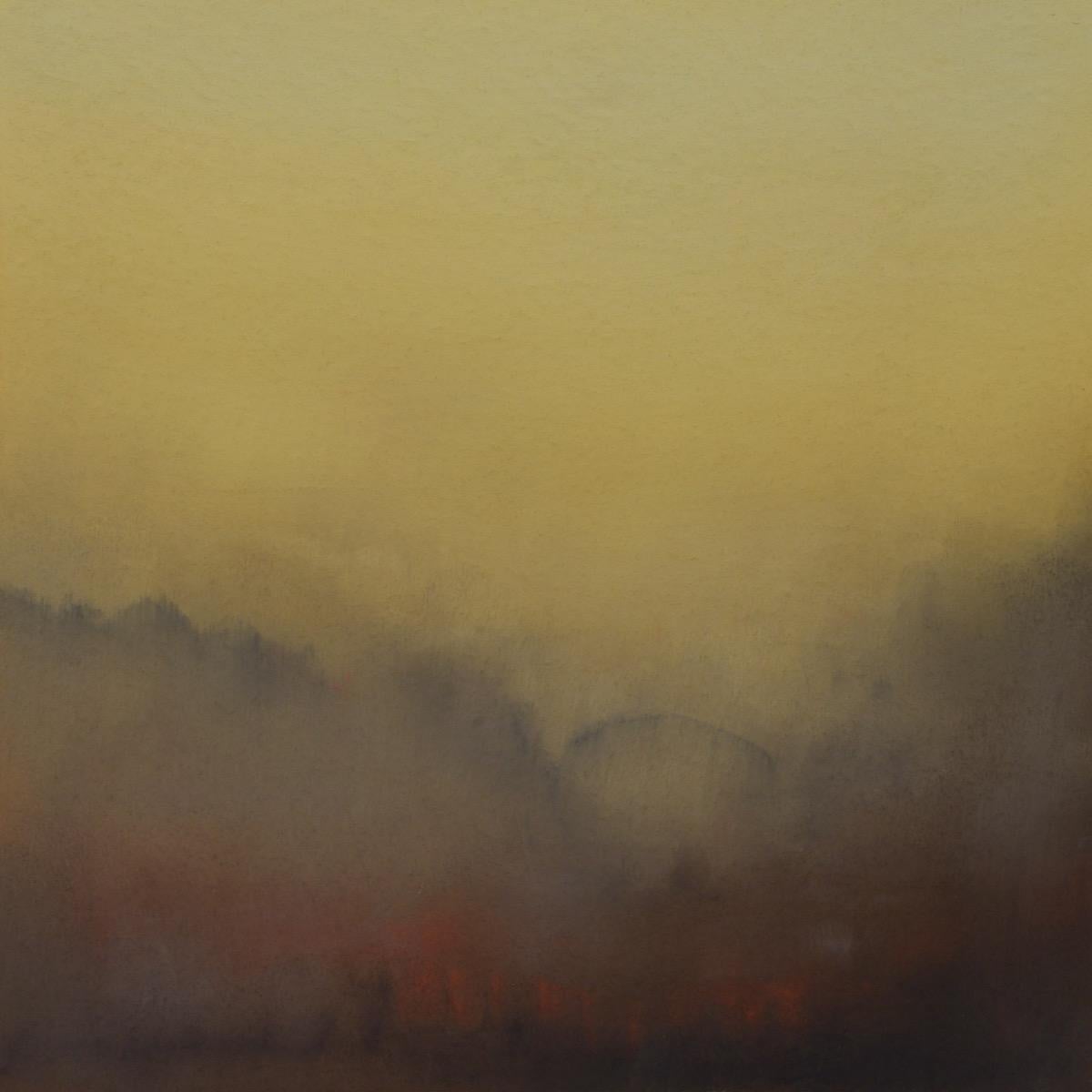Items Similar to Tayo Heuser, Nomad, 2013, Ink on handburnished paper, Abstraction, Meditative
Want more images or videos?
Request additional images or videos from the seller
1 of 4
Tayo HeuserTayo Heuser, Nomad, 2013, Ink on handburnished paper, Abstraction, Meditative 2013
2013
About the Item
By developing a geometry between line and the spaces in between in their work, the abstract paintings of Tayo Heuser create a point of departure for the mind into a spiritual consciousness.
The viewer is invited into experiencing this shared intelligence, the basis of all love.
By developing a geometry between line and the spaces in between in their work, the four abstractionists featured in Transcendental create a point of departure for the mind into a spiritual consciousness.
The viewer is invited into experiencing this shared intelligence, the basis of all love.
By developing a geometry between line and the spaces in between in their work, the four abstractionists featured in Transcendental create a point of departure for the mind into a spiritual consciousness.
The viewer is invited into experiencing this shared intelligence, the basis of all love.
Tayo Heuser's aspiration has always been to merge line and color in such a way that does not end in representational imagery but rather opens the door for the poetics of the imagination. Her abstractions hover between the need to meticulously render geometric shapes and intuitively express her feelings.
Heuser uses a labor- intensive paper sizing technique from the 1300’s that was used for Tugras and other calligraphic texts during the Ottoman Empire. The process includes egg white, alum and burnishing with a small agate stone resulting in a beautiful sheen whereby the ink sits on top of the paper creating a bit of dimension. Heuser experiments with hand made paper and inks on a continuous basis.
Most recently she has been painting on wood panel using inks and gouache. The surface is first coated with gesso, sanded, then repeated six times to create a smooth surface that will accept the steel nib.
Tayo Heuser was born in Washington D.C. but raised in North, East and West Africa. She returned to the United States to attend college at the Rhode Island School of Design.
As a child in Tunisia, she wandered the Roman ruins in Carthage admiring the vast expanses of the Roman market place and baths along with the Roman mosaics still embedded into the ground. The Great Mosque of Kairouan with its endless horseshoe arches and Islamic tiles formed an indelible visual memory of geometric design thus, beginning her interest in geometry entailed in creating patterns that would continue to inform her artwork. Her voyages through the Sahara exposed her to the night sky and an infinite horizon. The other end of the spectrum from the stillness of the desert would be in the Ivory Coast. Heuser would revel in the vibrant color of the textiles worn by the Ivorian people along with the varied and abundant vegetation.
Heuser's identity transcends her geography and political borders.
Her art rests in a meditative space throughout her process and gains insight into an unconscious world were colors and geometric forms emerge. Her paintings are like portals in that they represent a world of infinite possibilities that allow for reflectivity and timeless tranquility. They create a heightened perception of the world we live in, delving into untouched levels of reality. Heuser considers her paintings as passageways between her interior and exterior worlds akin to a spiritual excavation. She addresses the central theme of cosmic balance between light and darkness, spirit and matter. Her paintings embody energies that are released during these moments of profound solitude and quietude.
Heuser had a yearlong solo long exhibition at the Phillips Collection in Washington D.C. Recent solo exhibitions (2018) were at The UMass Dartmouth Gallery, MA, The Jamestown Art Center in RI (2016) and the Roger Williams University Gallery in Bristol, RI (2014). Group exhibitions include The Weatherspoon Museum, the Rhode Island School of Design Museum, the University Art Museum at Long Beach California and the Chazan Museum of Art. Her work has been exhibited internationally, most recently at the Chateau de Fernelmont in Belgium.
Heuser was awarded residencies with the BAU nchorInstitute, the Woman’s Studio Workshop and a travel grant from Roger Williams University to study papermaking in Japan. She was a Louis Comfort Tiffany Award nominee.
Heuser’s work is in the permanent collection of The RISD Museum, Providence RI, The Weatherspoon Museum, Greensboro, NC, The Hammer Museum Los Angeles, CA, and The Phillips Collection, Washington D.C. Other collections include the American Embassy in Jeddah, Saudi Arabia, the Leeds Foundation Philadelphia, PA, the Werner Kramarsky Collection NYC.
Heuser’s work has been featured in publications including, The Los Angeles Times, The Boston Globe, Art New England, Artscope, The Boston Herald, La Libre Magazine, Le Soir and the Washington Post.
- Creator:Tayo Heuser (American)
- Creation Year:2013
- Dimensions:Height: 56 in (142.24 cm)Width: 41 in (104.14 cm)
- Medium:
- Movement & Style:
- Period:
- Condition:This work of art can be framed with a false frame, for ideal presentation. The price for the frame is an additional $800. Size is 88 x 49 x 2 inches and has an archival backer board for the artwork to be attached.
- Gallery Location:Darien, CT
- Reference Number:1stDibs: LU17227714782
About the Seller
5.0
Vetted Seller
These experienced sellers undergo a comprehensive evaluation by our team of in-house experts.
Established in 2014
1stDibs seller since 2015
141 sales on 1stDibs
Typical response time: 16 hours
- ShippingRetrieving quote...Ships From: New York, NY
- Return PolicyA return for this item may be initiated within 7 days of delivery.
More From This SellerView All
- Josette Urso, Backyard 3, 2005, Ink Brush Drawing, 6 x 8 inBy Josette UrsoLocated in Darien, CTThe view from my studio, looking across Brooklyn’s lower lying factory and warehouse buildings toward the tall grandness of Manhattan, is incredibly complex and at times overwhelming...Category
Early 2000s Abstract Landscape Drawings and Watercolors
MaterialsArchival Paper, Ink
- Josette Urso, Backyard 1, 2005, Ink Brush Drawing, 6 x 8 inBy Josette UrsoLocated in Darien, CTThe view from my studio, looking across Brooklyn’s lower lying factory and warehouse buildings toward the tall grandness of Manhattan, is incredibly complex and at times overwhelming...Category
Early 2000s Abstract Landscape Drawings and Watercolors
MaterialsArchival Paper, Ink
- Josette Urso, Backyard 2, 2005, Ink Brush Drawing, 6 x 8 inBy Josette UrsoLocated in Darien, CTThe view from my studio, looking across Brooklyn’s lower lying factory and warehouse buildings toward the tall grandness of Manhattan, is incredibly complex and at times overwhelming...Category
Early 2000s Abstract Landscape Drawings and Watercolors
MaterialsArchival Paper, Ink
- Josette Urso, On Spot, 2019, Ink Brush Drawing, 12 x 13 inBy Josette UrsoLocated in Darien, CTThe view from my studio, looking across Brooklyn’s lower lying factory and warehouse buildings toward the tall grandness of Manhattan, is incredibly complex and at times overwhelming...Category
2010s Abstract Landscape Drawings and Watercolors
MaterialsArchival Paper, Ink
- Josette Urso, That Daffodil, 2019, Ink Brush Drawing, 12 x 13 inBy Josette UrsoLocated in Darien, CTThe view from my studio, looking across Brooklyn’s lower lying factory and warehouse buildings toward the tall grandness of Manhattan, is incredibly complex and at times overwhelming...Category
2010s Abstract Landscape Drawings and Watercolors
MaterialsArchival Paper, Ink
- Josette Urso, Broken, 2018, Ink Brush Drawing, 12 x 13 inBy Josette UrsoLocated in Darien, CTThe view from my studio, looking across Brooklyn’s lower lying factory and warehouse buildings toward the tall grandness of Manhattan, is incredibly complex and at times overwhelming...Category
2010s Abstract Landscape Drawings and Watercolors
MaterialsArchival Paper, Ink
You May Also Like
- MountainsBy Omar RayoLocated in Long Island City, NYAn early painting by Omar Rayo from 1955. An abstract geometric work with multi-colored shapes on a surrealist horizon. Artist: Omar Rayo, Colombian (1928 - ) Title: Mountains Year:...Category
1950s Abstract Geometric Abstract Paintings
MaterialsPaper, Acrylic
- Mountainscape inspired by M.Saryan-made in yellow, orange, red, blue, turquoiseBy Mila AkopovaLocated in Fort Lee, NJInterior design paintings. The ladscape was done with alcohol ink in yellow,orange,red,blue,green,pink color on Yupo paper. The work is 22 by 28 inches in siz...Category
2010s Abstract Expressionist Landscape Drawings and Watercolors
MaterialsPaper, Ink
- JOURNEY BEYOND: 'FAR AWAY'- CAPTIVATING WATERCOLOR AND INK MASTERPIECELocated in THOMERY, FR"Explore 'Far Away': Linda Clerget's enchanting masterpiece on paper, measuring 40 x 50 cm (15.7 x 19.7 inches). This exquisite piece features a gentle watercolor background in sooth...Category
21st Century and Contemporary Abstract Abstract Paintings
MaterialsInk, Watercolor
- A Small City Park, Abstract Painting Acrylic Watercolor Painting, Green BrownBy Edward MarecakLocated in Denver, CO"A Small City Park", acrylic and watercolor on paper by Denver artist Edward Marecak (1919-1993) of an abstract park broken into four quadrants, separated by brown and white striped borders with different shaped ponds. Inspired by City Park in Denver, Colorado where the artist frequented. Presented framed with all archival materials, outer dimensions measure 21 ¾ x 18 ¾ inches. Image size measures 12 x 15 inches. Painting is clean and in good condition - please contact us for a detailed condition report. Provenance: Estate of Edward Marecak Expedited and international shipping is available - please contact us for a quote. About the Artist: Born to immigrant parents from the Carpathian region in Slovakia, Marecak grew up with his family in the farming community of Bennett’s Corners, now part of the town of Brunswick, near Cleveland, Ohio. When he turned twelve, his family moved to a multi-ethnic neighborhood of Poles, Czechs, Slovaks and Slovenians in Cleveland. His childhood household cherished the customs and Slavic folk tales from the Old Country that later strongly influenced his work as a professional artist. During junior high he painted scenery for puppet shows of "Peter and the Wolf," awakening his interest in art. In his senior year in high school he did Cézanne-inspired watercolors of Ohio barns at seventy-five cents apiece for the National Youth Administration. They earned him a full scholarship to the Cleveland Institute of Art (1938-1942) where he studied with Henry George Keller whose work was included in the 1913 New York Armory Show. In 1940 Marecak also taught at the Museum School of the Cleveland Institute. Before being drafted into the military in 1942, he briefly attended the Cranbrook Academy of Art near Detroit, one of the nation’s leading graduate schools of art, architecture, and design. A center of innovative work in architecture, art and design with an educational approach built on a mentorship model, it has been home to some of the world’s most renowned designers and artists, including Eero Saarinen, Charles Eames, Daniel Libeskind and Harry Bertoia. Marecak’s studies at Cranbrook with painter Zoltan Sepeshy and sculptor Carl Milles were interrupted by U.S. army service in the Aleutian Islands during World War II. Following his military discharge, Marecak studied on the G.I. Bill at the Colorado Springs Fine Arts Center from 1946 to 1950, having previously met its director, Boardman Robinson, conducting a seminar in mural painting at the Cleveland Institute of Art. Although he did not work with Robinson at the Fine Arts Center, who had become quite ill - retiring in 1947 - he studied Robinson’s specialty of mural painting before leaving to briefly attend the Cranbrook Academy in 1947. That same year he returned to the Fine Arts Center, studying painting with Jean Charlot and Mary Chenoweth, and lithography with Lawrence Barrett with whom he produced some 132 images during 1948-49. At the Fine Arts Center he met his future wife, Donna Fortin, whom he married in 1947. Also a Midwesterner, she had taken night art courses at Hull House in Chicago, later studying at the Art Institute of Chicago with the encouragement of artist Edgar Britton. After World War II she studied with him from 1946 to 1949 at the Fine Arts Center. (He had moved to Colorado Springs to treat his tuberculosis.) Ed Marecak also became good friends with Britton, later collaborating with him on the design of large stained glass windows for a local church. In 1950-51 Marecak returned to the Cleveland Institute of Art to complete his Bachelor of Fine Arts degree. A year later he was invited to conduct a summer class at the University of Colorado in Boulder, confirming his interest in the teaching profession. In 1955 he received his teaching certificate from the University of Denver. Vance Kirkland, the head of its art department, helped him get a teaching job with the Denver Public Schools so that he and his family could remain in the Mile High City. For the next twenty-five years he taught art at Skinner, Grove, East, George Washington and Morey Junior High Schools. Prior to coming to Colorado, Marecak did watercolors resembling those of Winslow Homer, John Singer Sargent and Charles Burchfield. However, once in Colorado Springs he decided to destroy much of his earlier ouevre, embarking on a totally new direction unlike anything he had previously done. Initially, in the 1940s he was influenced by surrealist imagery and Paul Klee, and in the West by Indian petroglyphs and Kachinas. His first one-person show at the Garrett Gallery in Colorado Springs in 1949 featured paintings and lithographs rendered in the style of Magic Realism and referential abstraction. The pieces, including an oil Witch with Pink Dish, foreshadowed the output of his entire Colorado-based career, distinguished by a dramatic use of color, intricacy of execution and attention to detail contributing to their visual impact. He once observed, "Each time I start a new painting I always fool myself by saying this time keep it simple and not get entangled with such complex patterns, color and design; but I always find myself getting more involved with richness, color and subject matter." An idiosyncratic artist proficient in oil, acrylic, watercolor, gouache and casein, he did not draw upon Colorado subject matter for his work, unlike many of his fellow painters in the state. Instead he used Midwest landscape imagery, bringing to life in it witches and spirits adapted from the Slovakian folk tales he heard growing up in Ohio. A number of his paintings depict winter witches derived from the Slovak custom in the Tatra Mountains of burning an effigy of the winter witch in the early spring to banish the memory of a hard winter. The folk tale element imparts a dream-like quality to many of his paintings. A devote of Greek mythology, he placed the figures of Circe, Persephone, Sybil, Hera and others in modern settings. The goddess in Persephone Brings a Pumpkin to her Mother, attired as a Midwestern farmer’s daughter, heralds the advent of fall with the pumpkin before departing to spend the winter season in the underworld. Train to Olympus, the meeting place of the gods in ancient Greece, juxtaposes ancient mythology with modernity creating a combination of whimsy and thought-provoking consideration for the viewer. Voyage to Troy #1 alludes to the ancient city that was the site of the Trojan Wars, but has a contemporary, autobiographical component referencing the harbor of the Aleutian Islands recaptured from the Japanese during World War II. In the 1980s Marecak used the goddess Hera in his painting, Hera Contemplates Aspects of the Art Nouveau, to comment on art movements in the latter half of the twentieth century Marecak’s love of classical music and opera, which he shared with his wife and to which he often listened while painting in his Denver basement studio, is reflected in Homage of Offenbach, an abstract work translating the composer’s musical colors into colorful palette. Pace, Pace, Mio Dio, the title of his earliest surrealist painting, is a soprano aria from Verdi’s opera, La Forza del Destino (The Force of Destiny or Fate, a favorite Marecak subject). His Queen of the Night relates to a character from Mozart’s opera, The Magic Flute. In addition to paintings and works on paper, he produced hooked rugs, textiles and ceramics. He likewise produced designs for ceramics, tableware and furniture created by his wife Donna, an accomplished Colorado ceramist. Both of them generally eschewed exhibitions and galleries, preferring to quietly do their work while remaining outside of the mainstream. He initially exhibited at the Colorado Springs Fine Arts Center in 1948 receiving a purchase award. The following year he had his first one-person show of paintings and lithographs at the Garrett Gallery in Colorado Springs. In the 1950s and early 1960s he participated in group exhibitions at the Print Club (Philadelphia); Amarillo Public Library (Texas); annual Blossom Festival Show (Canon City, Colorado); Adele Simpson’s "Art of Living" in New York; Denver Art Museum; and the Fox Rubenstein-Serkey Gallery (Denver); but he did not have another one-person show until 1966 at the Denver home of his friends, John and Gerda Scott. They arranged for his first one-person show outside of Colorado held two years later at the Martin Lowitz Gallery in Beverly Hills and Palm Springs, California. That same year his work was featured at the Zantman Galleries in Carmel, California. Thereafter he became an infrequent exhibitor after the 1970s so that his work was rarely seen outside his basement studio. In 1980 he, his wife and Mark Zamantakis exhibited at Denver’s Jewish Community Center, and four years later he had a one-person show at the Studio Gallery in Denver. In 1992 he was included in a group show at the Rule Modern and Contemporary Gallery in Denver, and a year later received a large, posthumous retrospective at the Emmanuel...Category
Mid-20th Century Abstract Abstract Paintings
MaterialsPaper, Acrylic, Watercolor
- Untitled (Abstract, Vibrant, Drips, Neon, Gestural, Contemporary, Expressionism)By Russell ShoemakerLocated in Kansas City, MORussell Shoemaker Title: Untitled Year: 2018 Medium: Gouache on Yupo Paper Size: 12 x 9 inches Signed, dated and inscribed by the artist Russell Shoemaker received his BFA from the ...Category
2010s Abstract Impressionist Landscape Drawings and Watercolors
MaterialsGouache, Synthetic Paper
- Unbearable Lightness I, Original art, Oil pastel on paper, Landscape, AbstractBy Richard WhadcockLocated in Deddington, GBUnbearable Lightness I by Richard Whadcock is a beautiful misty landscape depicting a golden translucent sky, brown translucent trees and a hint of orangy rust trees, giving the pain...Category
2010s Abstract Landscape Drawings and Watercolors
MaterialsOil Pastel, Paper
Recently Viewed
View AllMore Ways To Browse
Ink Stone
Japan Ink Wood
Tiffany Paper
Roman Empire Art
Louis Comfort Tiffany Award
Geometric Horizon
Hammered Steel Art
Egg White Used In Painting
Japanese Ink Calligraphy
Tiffany Roman
Roman Mosaics
Roman Mosaic
Painting East End Long Island
Paintings By Louis Comfort Tiffany
Ottoman Painting
Dark Tiffanys
Abstract Paper Mosaic
New Light On Tiffany





